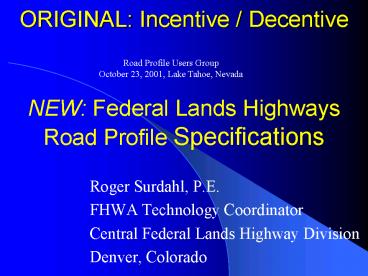ORIGINAL: Incentive Decentive - PowerPoint PPT Presentation
1 / 13
Title:
ORIGINAL: Incentive Decentive
Description:
October 23, 2001, Lake Tahoe, Nevada. Pavement Quality. Acceptance Parameters. Asphalt Content ... Two lifts of asphalt required 50 segments of 1/10th km each ... – PowerPoint PPT presentation
Number of Views:156
Avg rating:3.0/5.0
Title: ORIGINAL: Incentive Decentive
1
ORIGINAL Incentive / Decentive
Road Profile Users Group October 23, 2001, Lake
Tahoe, Nevada
NEW Federal Lands Highways Road Profile
Specifications
- Roger Surdahl, P.E.
- FHWA Technology Coordinator
- Central Federal Lands Highway Division
- Denver, Colorado
2
Pavement QualityAcceptance Parameters
- Asphalt Content
- Aggregate Gradation
- Density
- Pavement Smoothness
3
Pavement Smoothness
- Applies Only to the Final Surface
- Pavement Smoothness Types I, II, III, and IV
- Profile Index mm/km
- Type Upper Spec Limit Defective Limit
- I 80 160
- II 125 190
- III 160 240
- IV Straightedge, 6 mm (max) in 3 m
4
FHWAs StatisticalAcceptance Specification
- Specification Target Values or Limits
- Measured Average and Standard Deviation
- Quality Index, Qu (USL - Avg) / Sd
- Percent of Work Outside Specifications
- Pay Factors
- 105 Maximum Incentive (0 defective)
- 75 Maximum Disincentive (40 defective)
- lt75 Remove and Replace
5
Example Calculation
Type III Roadway 5 km in length USL 160
mm/km 50 segments of 1/10th km each One
bridge, exclude that segment For the 49
Remaining Segments Final PRI Average 130
mm/km Final Standard Deviation 20 mm/km Qu
(USL - Avg) / Sd gtgtgt (160 130) / 20
1.50 Percent Outside Specifications
6 Therefore, Pay Factor 102
6
FHWA Smoothness Study - Measured over 220
projects at 0.2 blanking band - Found that 95
of all contractors could improve smoothness by ½
for each 1-1/2 inch overlay
7
0.0 BB Smoothness
- Found the 0.2 blanking band data was not
normally distributed - Re-measured 21 projects at 0.0 blanking band
- Developed a statistical correlation shift of a
PRI average of 14 points
8
Correlation Equations for the 0.2 and 0.0
Blanking Bands
- Profile Ride Index
- 0.0 PRI BB 14.1043 1.0832(0.2 PRI BB)
- R2 0.85
- Standard Deviation
- 0.0 SD BB 1.06186 1.12765(0.2 Sd BB)
- R2 0.92
9
New Pavement Smoothness Specification
- Three Roadway Types
- I New (310 mm/km)
- II Overlays
- III Excluded Areas
- Based on 0.0 blanking band
- Statistical acceptance methods still apply
10
Type II Overlay Smoothness
- Still uses California
- type Profilograph
- Contractor measures
- existing PRI (310 min)
- and STD to calculate
- USL based on one or
- two lifts
- USL C Sd
- Where
- USL is Upper Spec Limit
- C is a Smoothness Constant
- Sd is Standard Deviation
- Contractor measures final PRI to calculate Pay
Factor
11
Table 401-3 (excerpt)Overlay and Recycle
Smoothness Constants(C) and Standard
Deviation(Sd) for Determining Upper Specification
Limits(USLx)
12
Example Calculation
Type II Roadway 5 km in length Two lifts of
asphalt required 50 segments of 1/10th km
each Minimum PRI 310 mm/km One bridge, exclude
that segment For the 49 Remaining
Segments Existing PRI Average 290 mm/km, Use
310 mm/km Existing Standard Deviation 20
mm/km USL C2 Sd2 gtgtgt 108.9 104.2 213.1
mm/km After paving two lifts, for the 49
Remaining Segments Final Average 185
mm/km Final Standard Deviation 15 mm/km
Qu (USL - Avg) / Sd gtgtgt (213.1 185) / 15
1.87 Percent Outside Specifications
2 Therefore, Pay Factor 105
13
Conclusion
- FLH will continue to refine the specification as
more data are generated - Implementation in 2003
- The focus is still on smooth roadways
- More uniform application of acceptance criteria
and farer sharing of the risks

